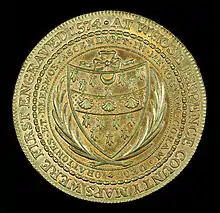Thomas Seckford
Thomas Seckford (1515 – January 1587) was an official at the court of Queen Elizabeth I and Member of Parliament.[1] He is not to be confused with his younger brother, Thomas Seckford of Ludlow, also a Member of Parliament.[2]
Life
Born near Woodbridge, Suffolk, England, Seckford was educated at Cambridge,[3] and in 1540 entered Gray's Inn. Thomas became one of Queen Elizabeth I’s two Masters in Ordinary of the Court of Requests (from 1558 probably until death) which dealt with poor men’s causes.[4] One of the duties of this post was to accompany the monarch as she journeyed around her realm. He would thus have been particularly known to the Queen. He is believed to have played a prominent part in arranging the Elizabethan Church Settlement. In 1564, she sold him the manor of Woodbridge, including the site of Woodbridge Priory, and he became a benefactor to both the church and town.[5] He was junior Knight of the Shire (MP) for Suffolk in 1571.
He was an MP for Ripon in November 1554, for Orford in 1555 and 1558, for Ipswich in 1559, 1563 and 1572 and for Suffolk in 1571.[6]
Elizabeth is known to have held court at the Seckford family seat, Seckford Hall.
In 1574 Thomas commissioned Christopher Saxton to survey all the English counties and produce an atlas of the realm. This was published in 1579, the first ever done from an actual survey. Elizabeth granted him a patent for its sole publication for ten years.
He founded seven almshouses in Woodbridge in 1586 which he endowed with an income of £112 13s 4d (£112.66p) per year from land in Clerkenwell, Middlesex. He also paid for the old Woodbridge Abbey to be rebuilt. His wealth is still benefiting Woodbridge today.
He died in 1587 aged 72, never having had children, and was buried in a chapel on the north side of St. Mary's Church which is now an organ chamber. His coat of arms can be seen in the north window of the west wall of the church.
Sekforde Street in Clerkenwell, London, is built on land once owned by Seckford and is named for him. Sekforde Street adjoins Woodbridge Street, laid out at the same time in the 1830s.
In the film About a Boy starring Hugh Grant the main character, Will, lives in a flat in No.1 Sekforde Street (actual research shows the temporary movie-set doorway was constructed at 16-18 St James's Walk, the same glazed-brick building but around the corner.) Woodbridge Chapel on Woodbridge Street also features in the film as the scene of the "Single Parents Alone Together" (SPAT) meeting.


References
- 'Seckford, Thomas I (1515 or 1516-87), of Woodbridge and Ipswich, Suff. and Clerkenwell, London', in P.W. Hasler (ed.), The History of Parliament: the House of Commons 1558-1603 (from Boydell and Brewer, 1981), History of Parliament online.
- J.J.C., 'Seckford, Thomas II (d.c.1579), of Ludlow, Salop', in P.W. Hasler (ed.), The History of Parliament: the House of Commons 1558-1603 (from Boydell and Brewer 1981), History of Parliament online. The Old Dictionary of National Biography article confuses both brothers and their father all together.
- "Sackford, Thomas (SKFT515T)". A Cambridge Alumni Database. University of Cambridge.
- "Masters of Requests". Institute of Historical Research. Retrieved 17 June 2013.
- The Abbey (Junior School), Woodbridge, British Listed Buildings. Retrieved 2011-05-01.
- History of Parliament online.
- Bunn, Michael, "A Short History of Seckford Hall", pub. by Hayes
- J. H. Baker, ‘Seckford, Thomas (1515/16–1587)’, Oxford Dictionary of National Biography, Oxford University Press, 2004 accessed 29 April 2007